ATI RN Proctored Nursing Care of Children Form B
Document Content and Description Below
ATI RN Proctored A nurse is providing dietary teaching to the parent of a child who has cystic fibrosis. Which of the following dietary recommendations should the nurse make? A. Increase the chil... d's protein intake B. Decrease the child's calorie intake C. Increase the child's fiber intake D. Decrease the child's salt intake Correct Answer: A. increase the childs protein intake The nurse should recommend an increased protein intake for the child who has cystic fibrosis. These children require up to 150% of the recommended daily allowance to meet their nutritional needs. A nurse is assessing a 6-year-old client at a well-child visit. Which of the following findings requires further assessment by the nurse? A. Presence of sparse, fine pubic hair B. Decreased head circumference compared to full height C. Increased leg length in relation to height D. Presence of a loose central incisor Correct Answer: A. Presence of sparse, fine pubic hair. A nurse is assessing a preschooler who has HIV. Which of the following manifestations should the nurse expect? A. Generalized petechiae B. Jaundice C. Obesity D. Chronic diarrhea Correct Answer: D. Chronic diarrhea Chronic diarrhea is an expected finding for a preschooler who has HIV. A nurse is providing postoperative teaching to the parent of a 3-month-old infant who is recovering from an umbilical hernia repair. Which of the following statements by the parent indicates an understanding of the teaching? A. "I will expect the site to bulge when my baby cries." B. "I will place a belly band around my baby's abdomen." C. "I will fold my baby's diaper away from the incision." D. "I will bathe my child in the bathtub daily." Correct Answer: C. I will fold by babys diaper away from the incision. A nurse is providing teaching to the parent of a child who has cystic fibrosis and a prolapsed rectum. The nurse should identify that which of the following is a cause of this complication? A. Bulky stools B. Weakened rectal sphincter C. Elevated pancreatic enzymes D. Decreased intra-abdominal pressure Correct Answer: A. Bulky stools. The nurse should identify that bulky stools can cause a child who has cystic fibrosis to develop a prolapsed rectum. The nurse should implement interventions to help decrease the bulk of the child's stools. A nurse in the emergency department is assessing an infant who recently started taking digoxin to treat a supraventricular arrhythmia. Which of the following findings should the nurse identify as an indication of digoxin toxicity? A. Irritability B. Diaphoresis C. Vomiting D. Tachycardia Correct Answer: C. Vomiting A nurse in the emergency department is caring for an unaccompanied infant following a motor-vehicle crash. During the assessment, the nurse notes that the infant's anterior fontanel is almost closed. She has 6 teeth, is able to sit unsupported, and can drink from a cup. The child cries whenever anyone new to her enters the room, says a few words, and is asking for "mama" and "dada." The nurse should make which of the following age assessments for this child? A. 6 months old B. 12 months old C. 18 months old D. 24 months old Correct Answer: B The nurse should know that this infant must be less than 18 months old because her anterior fontanel is still open. The infant is approximately 12 months old due to the presence of 6 teeth. Her skills—sitting unsupported (8 months), drinking well from a cup (9 months), stranger anxiety (8 months), and ability to say 2 words (12 months)—should also help the nurse estimate the infant's age as 12 months. A nurse is caring for a preschool-age child who is dying. Which of the following findings is an age-appropriate reaction to death by the child? (Select all that apply.) A. The child views death as similar to sleep. B. The child is interested in what happens to the body after death. C. The child recognizes that death is permanent. D. The child believes his thoughts can cause death. E. The child thinks death is a punishment. Correct Answer: A. The child views death as similar to sleep. D. The child believes his thoughts can cause death. E. The child thinks death is a punishment. Preschool-age children may think of death like sleep. Preschool-age children also believe that their thoughts and wishes can make things happen since they are egocentric. This is part of why the death of a family member can be difficult for a child at this age. Finally, preschool-age children sometimes believe that death is the result of guilt or a punishment for something they did, said, or thought. A nurse is assessing a 6-month-old infant during a well-child visit. Which of the following motor activities should the nurse expect the infant to have achieved? A. Sitting alone B. Attempting to stack objects C. Picking up small objects with a crude pincer grasp D. Turning from back to stomach Correct Answer: D. Turning from back to stomach. A nurse is providing teaching about immunization schedules to the parents of a newborn who is 1 week old. Which of the following pieces of information should the nurse include in the teaching? A. "Initial vaccines should be administered between birth and 2 weeks of age." B. "Your child will need to begin the vaccination series over again if subsequent doses in the series are missed." C. "An allergic reaction to a vaccine is due to the active ingredient in the vaccine." D. "A vaccination should be postponed if your child has a rectal temperature of 99.5°F and head congestion." Correct Answer: A. The first dose of the hepatitis B vaccine should be administered within the first 2 weeks after birth. The dose should be given before discharge from the hospital if the mother is hepatitis B surface antigen (HBsAg) negative. A nurse is teaching a group of parents of toddlers about measures to reduce the risk of choking. Which of the following foods increase the risk of choking in toddlers? (Select all that apply.) A. Hot dogs B. Grapes C. Bagels D. Marshmallows E. Graham crackers Correct Answer: A, B, C, D A nurse is teaching the parent of a child who has ADHD and a new prescription for methylphenidate sustained-release tablets. Which of the following pieces of information should the nurse include in the teaching? A. "Crush the medication and mix it in your child's food." B. "Administer the medication 1 hour before bedtime." C. "Expect your child to have cloudy urine while he is taking this medication." D. "Weigh your child twice per week while he is taking this medication." Correct Answer: D The nurse should instruct the parent to weigh the child 2 to 3 times per week to monitor for weight loss, which is an adverse effect of methylphenidate. The parent should report weight loss to the provider. A nurse is creating a plan of care for a preschooler who was admitted for the treatment of measles. Which of the following activities should the nurse include in the client's care plan? A. Constructing a model airplane B. Playing a video game in the playroom C. Pulling a wagon with toys in the hallway D. Putting together a puzzle with large pieces Check Answer Correct Answer: D. Putting together a puzzle with large pieces. A nurse is providing discharge teaching for the parent of a newborn who is prescribed a Pavlik harness for developmental dysplasia of the hip. Which of the following responses indicates an understanding of the teaching? A. "I should apply powder to the folds of skin on my baby's knees and thighs." B. "I should adjust the straps on the harness once a week as my baby grows." C. "I should lightly massage my baby underneath the straps once a day." D. "I should place my baby's diaper over the straps of the harness." Correct Answer: C. "I should lightly massage my baby underneath the straps once a day." The nurse is preparing to administer an oral medication to an 8-month-old infant. Which of the following actions should the nurse take? A. Mix the medication with 1 tsp of honey to sweeten the taste for the infant B. Use an oral syringe to place the medication alongside the infant's tongue C. Add the medication to the infant's bottle of formula D. Place the infant in a supine position to administer the medication Correct Answer: B. Use an oral syringe to place the medication alongside the infant's tongue The nurse should use an oral syringe to administer the medication slowly alongside the infant's tongue or at the side of the mouth. The nurse should give the child time to swallow between deposits. A nurse is assessing a 6-month-old infant who had a cardiac catheterization with right femoral entry to diagnose a possible congenital heart defect. Which of the following findings should the nurse report to the provider? A. Cool toes on the right foot B. Weak pedal pulses on both feet C. Positive Babinski reflex on both feet D. Erythema on the right foot Correct Answer: A. Cool toes on the right foot The nurse should monitor the temperature of the infant's right extremity and should report any indication of coolness distal to the entry site to the provider because this can indicate an obstruction of an artery. A nurse is providing teaching to the guardians of an infant who has failure to thrive (FTT). Which of the following pieces of information should the nurse include in the teaching? A. Add fortified rice cereal to the infant's formula B. Alternate feedings between several family members C. Offer the infant juice between feedings D. Provide feedings on demand rather than on a schedule Correct Answer: A. Add fortified rice cereal to the infants formula The nurse should inform the guardians that adding fortified rice cereal or vegetable oil to the infant's formula helps promote weight gain. A nurse is teaching the parent of an infant about home safety. Which of the following pieces of information should the nurse include? (Select all that apply.) A. Use a wheeled infant walker. B. Place soft pillows around the edge of the infant's crib. C. Position the car seat so it is rear-facing. D. Secure a safety gate at the top and bottom of the stairs. E. Maintain the water heater temperature at 49°C (120°F). Correct Answer: C, D, E C. Position the car seat so it is rear-facing. D. Secure a safety gate at the top and bottom of the stairs. E. Maintain the water heater temperature at 49°C (120°F). A nurse is assessing a toddler who has gastroenteritis. Which of the following findings indicates the toddler is experiencing severe dehydration? [Show More]
Last updated: 8 months ago
Preview 1 out of 18 pages
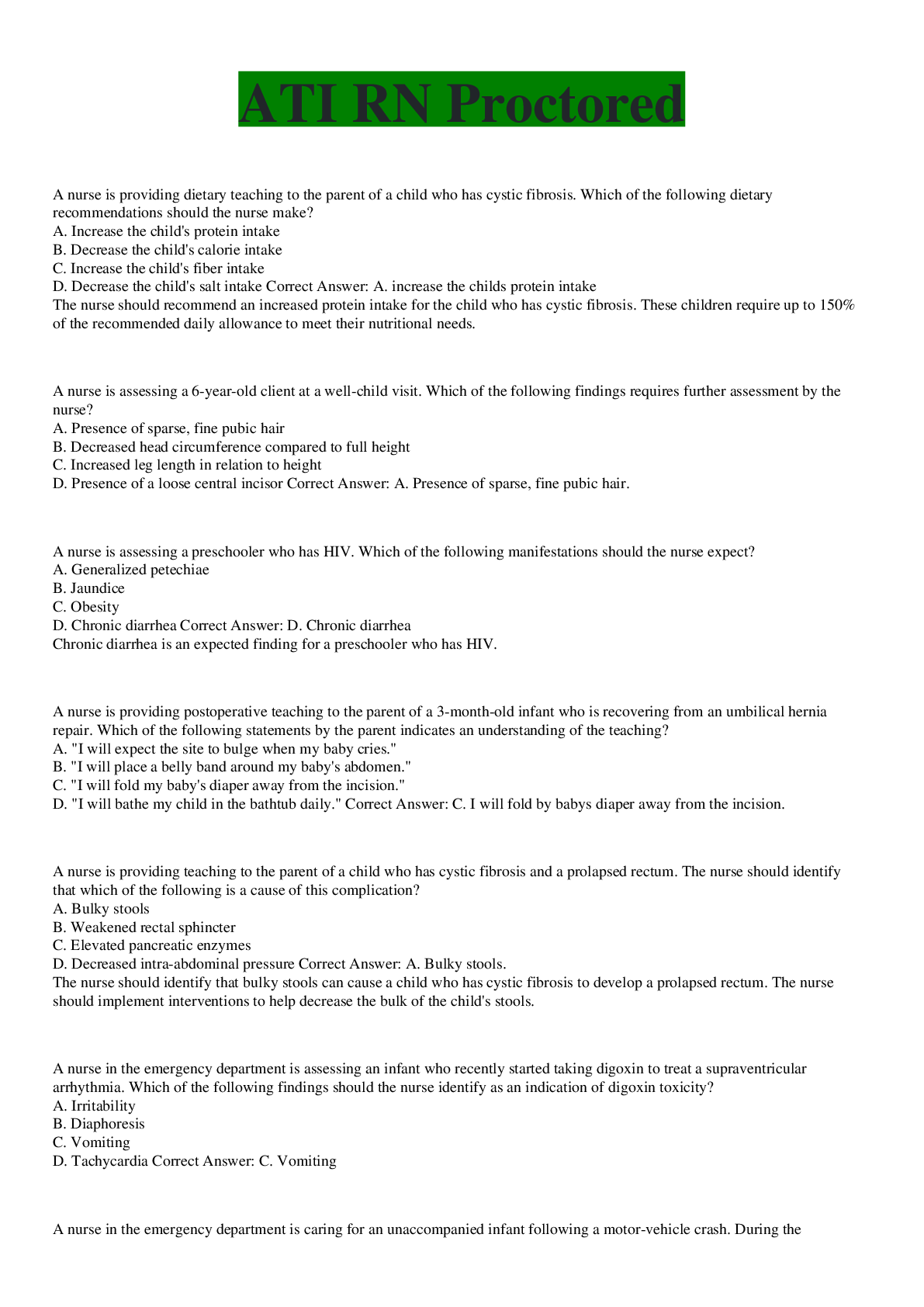
Reviews( 0 )
Document information
Connected school, study & course
About the document
Uploaded On
Jul 09, 2022
Number of pages
18
Written in
Additional information
This document has been written for:
Uploaded
Jul 09, 2022
Downloads
1
Views
127


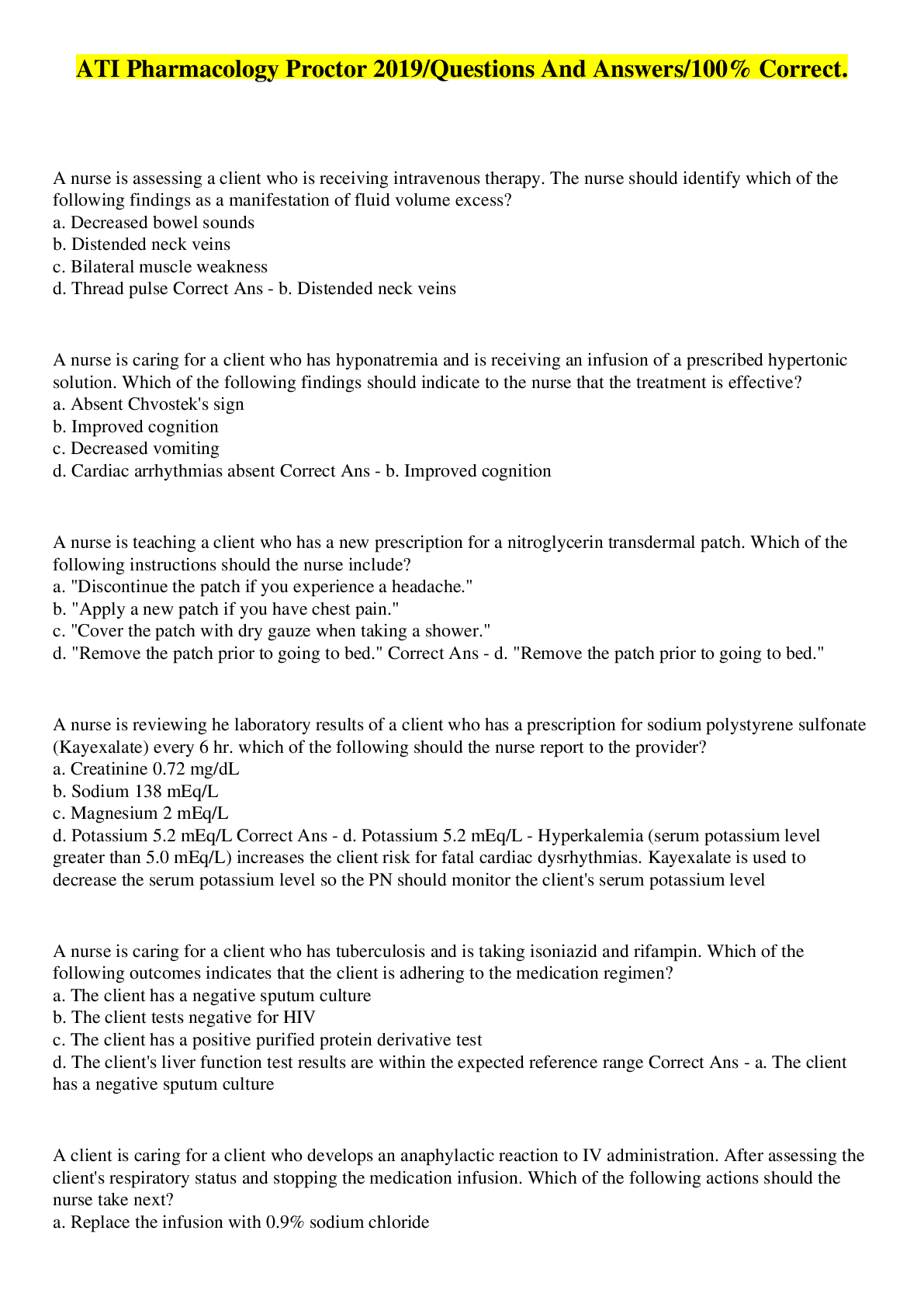

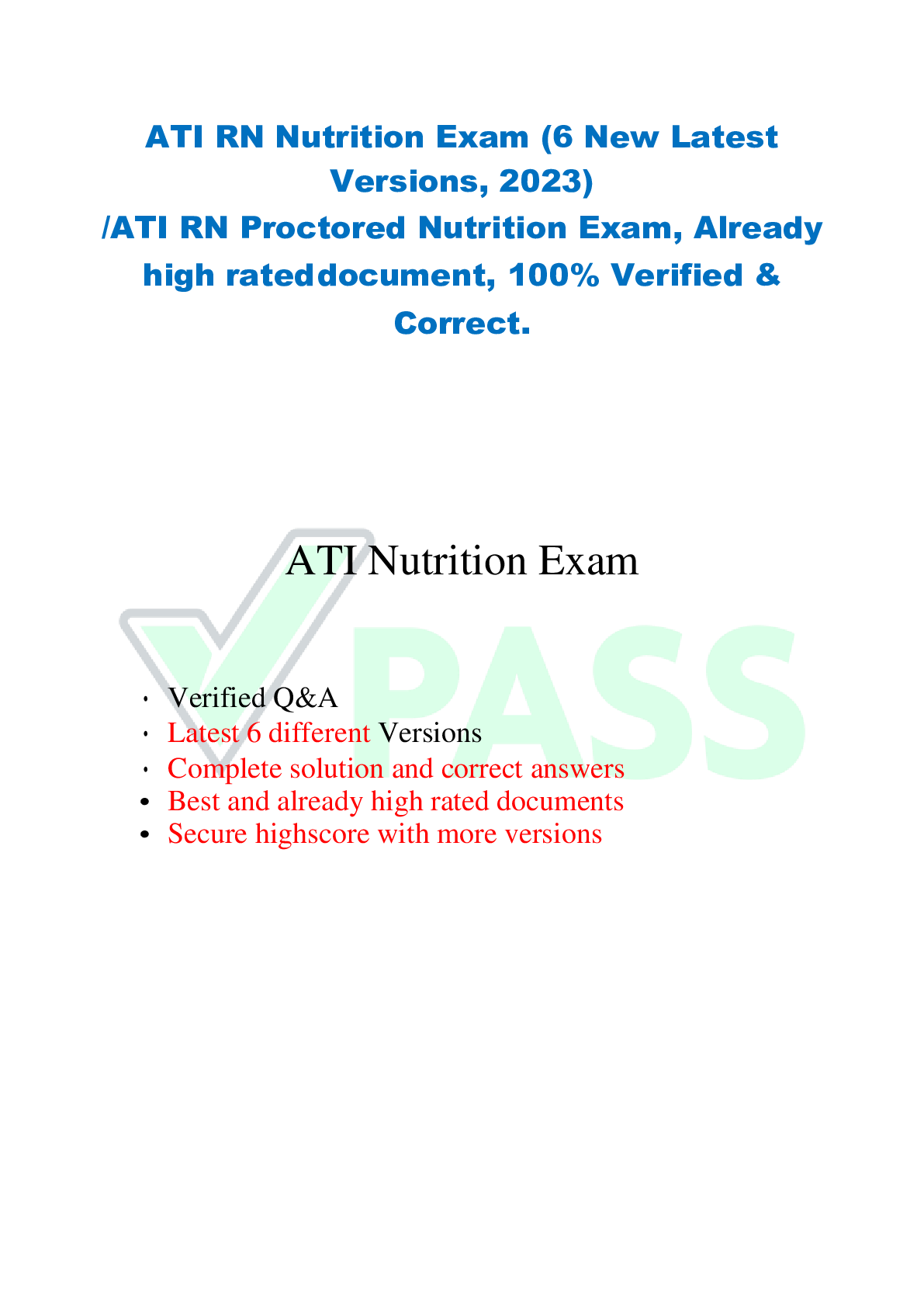




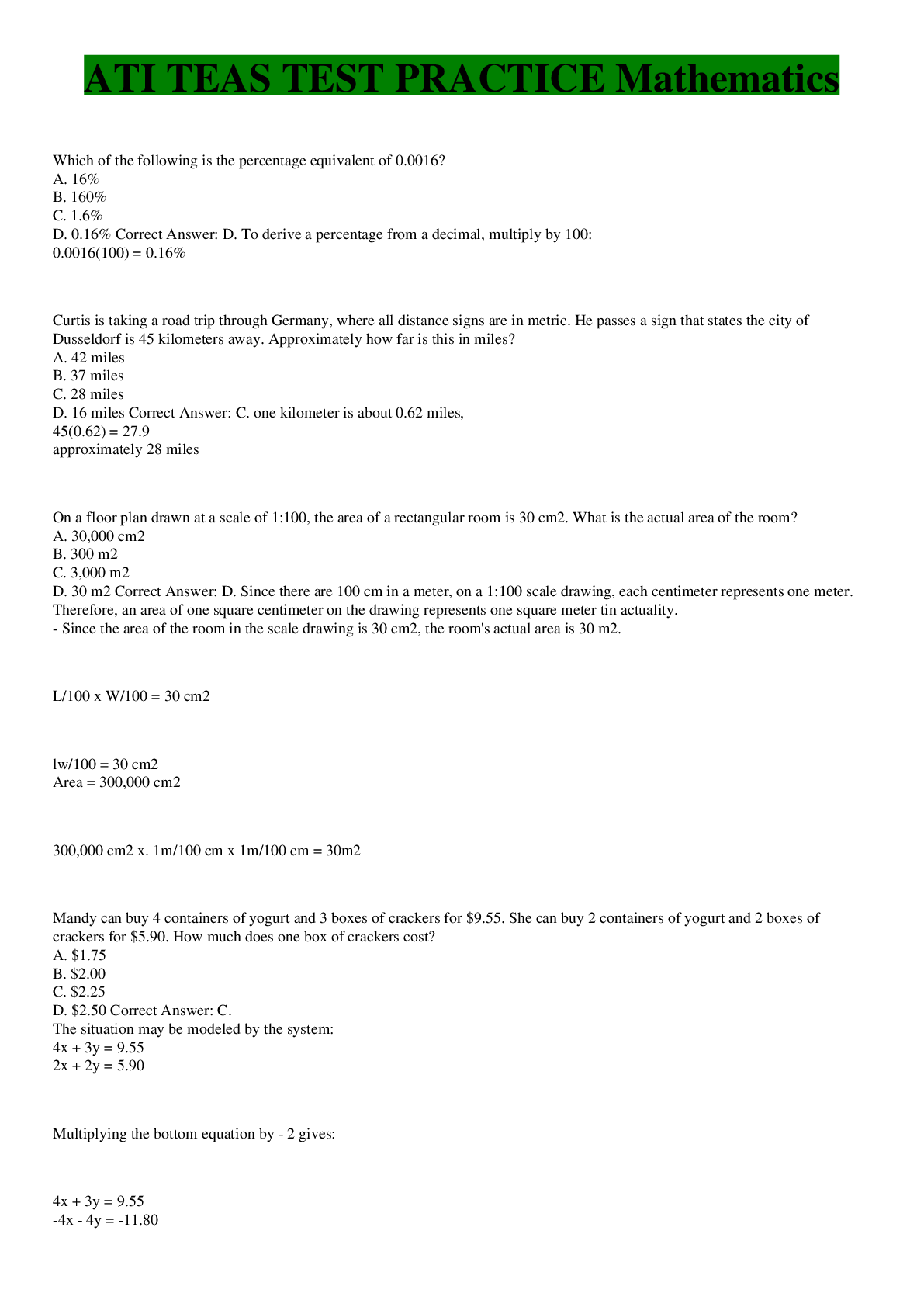

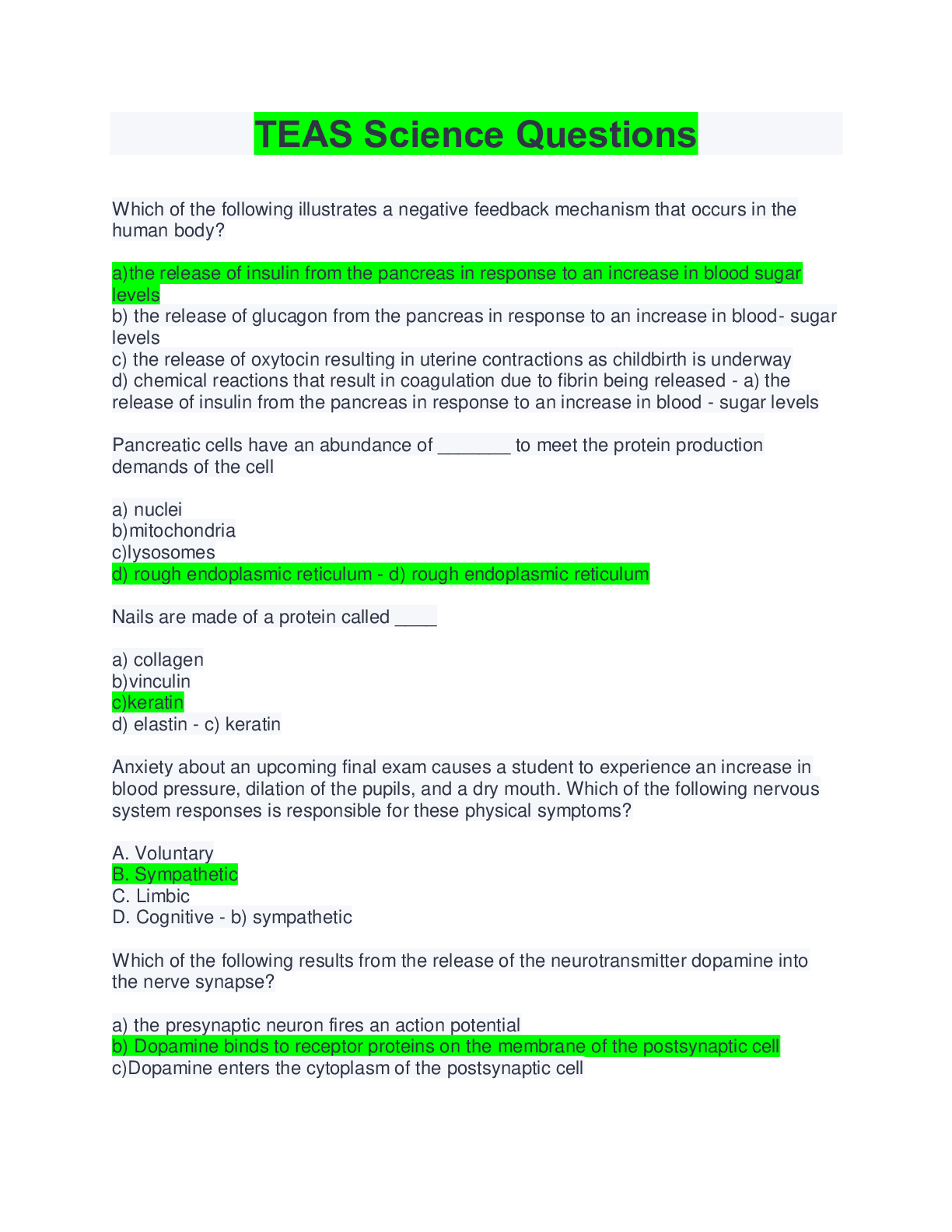
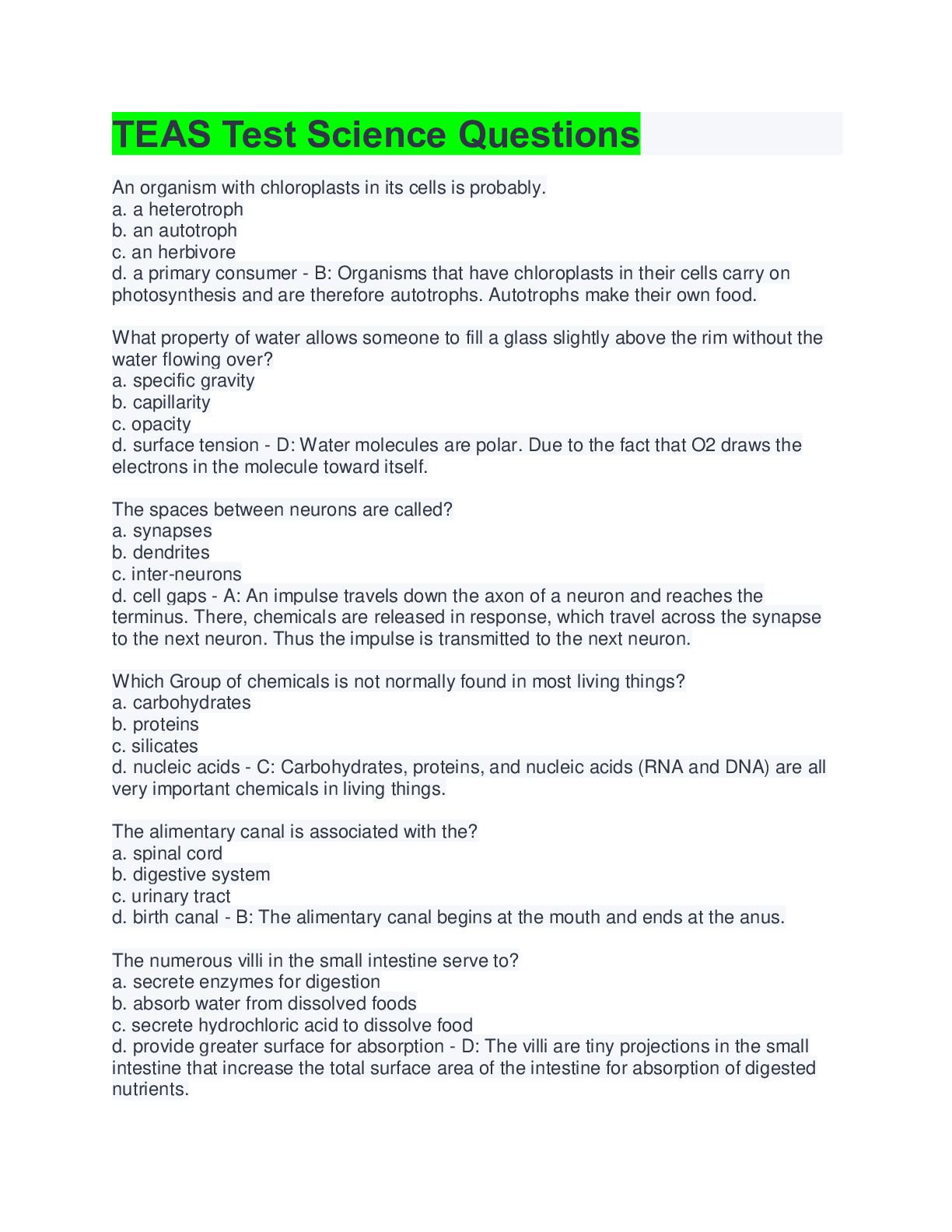

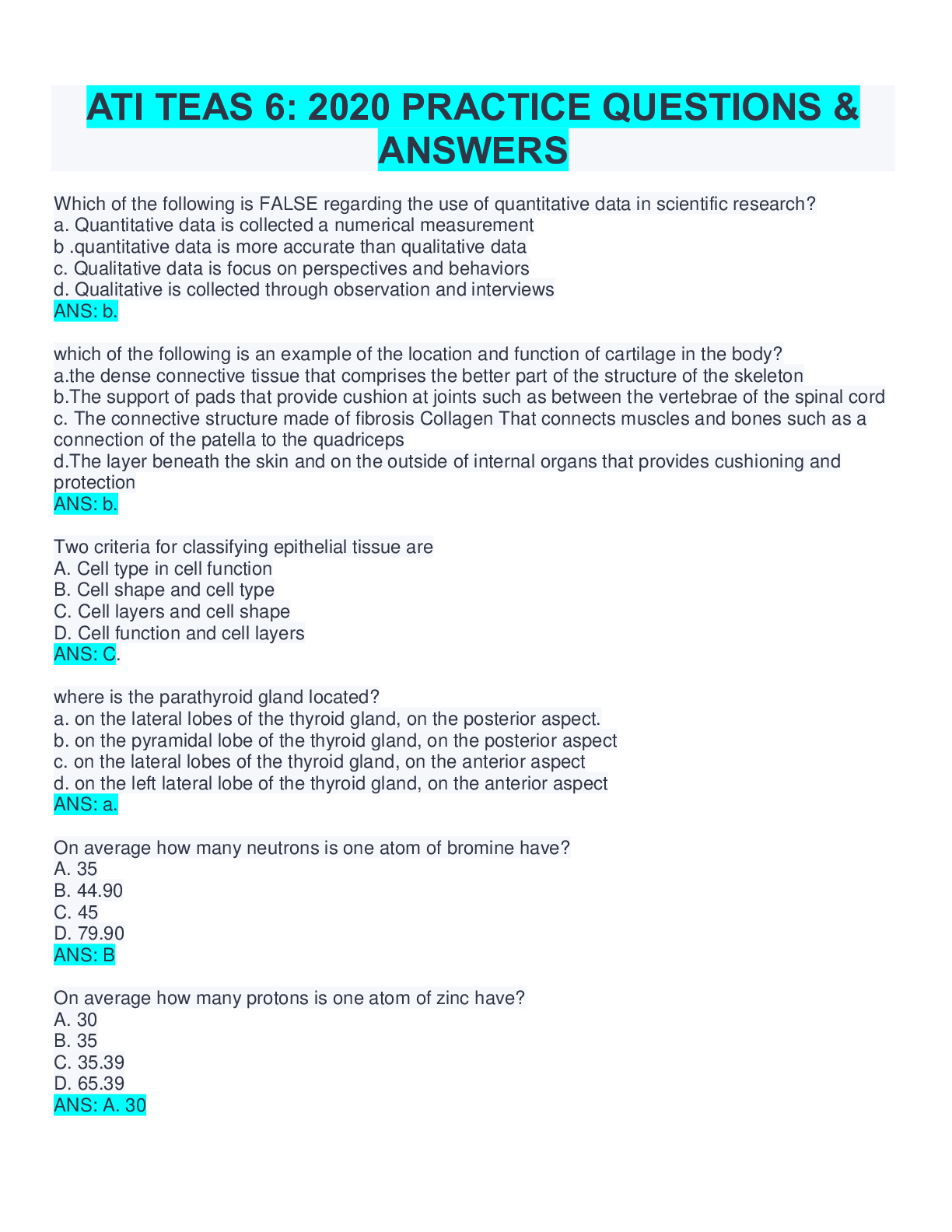





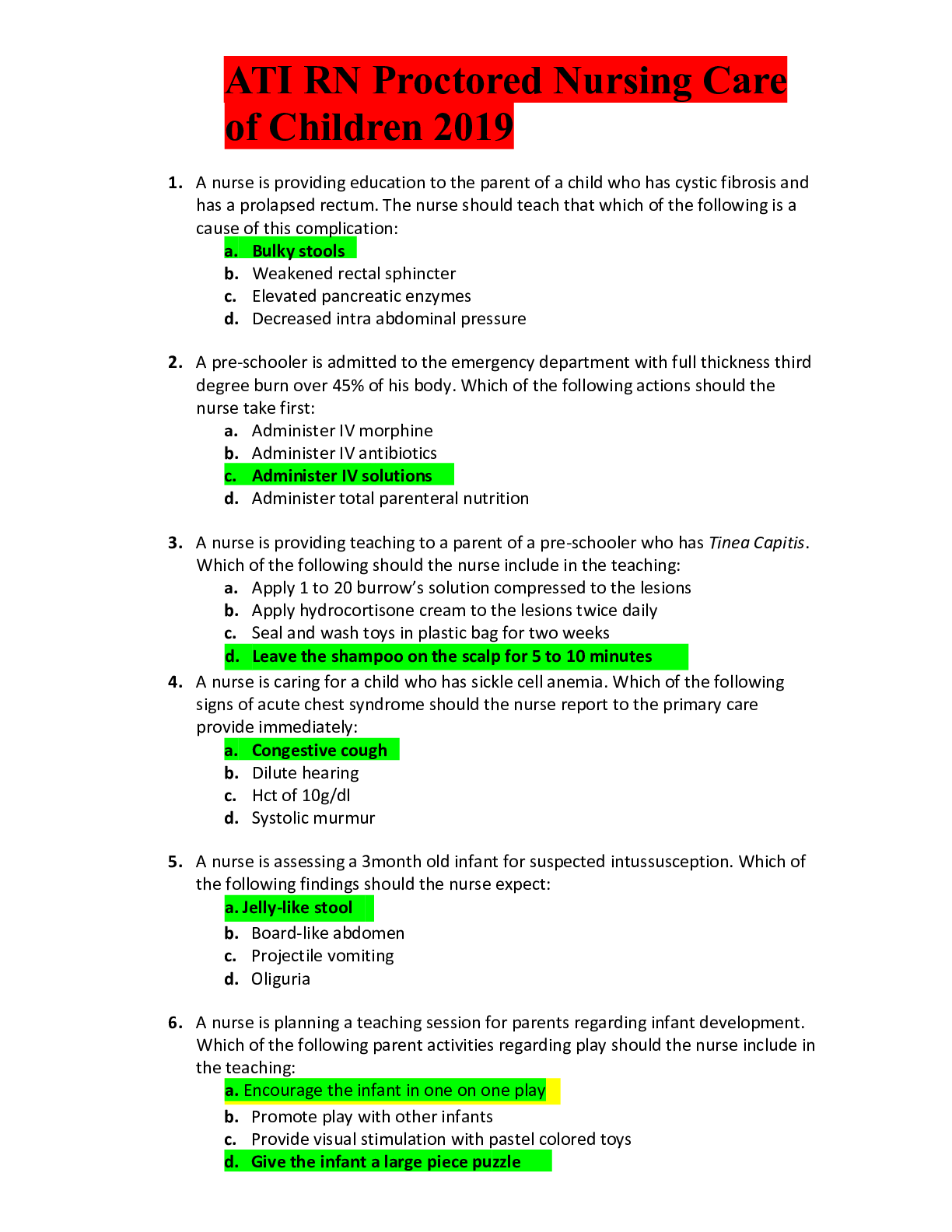
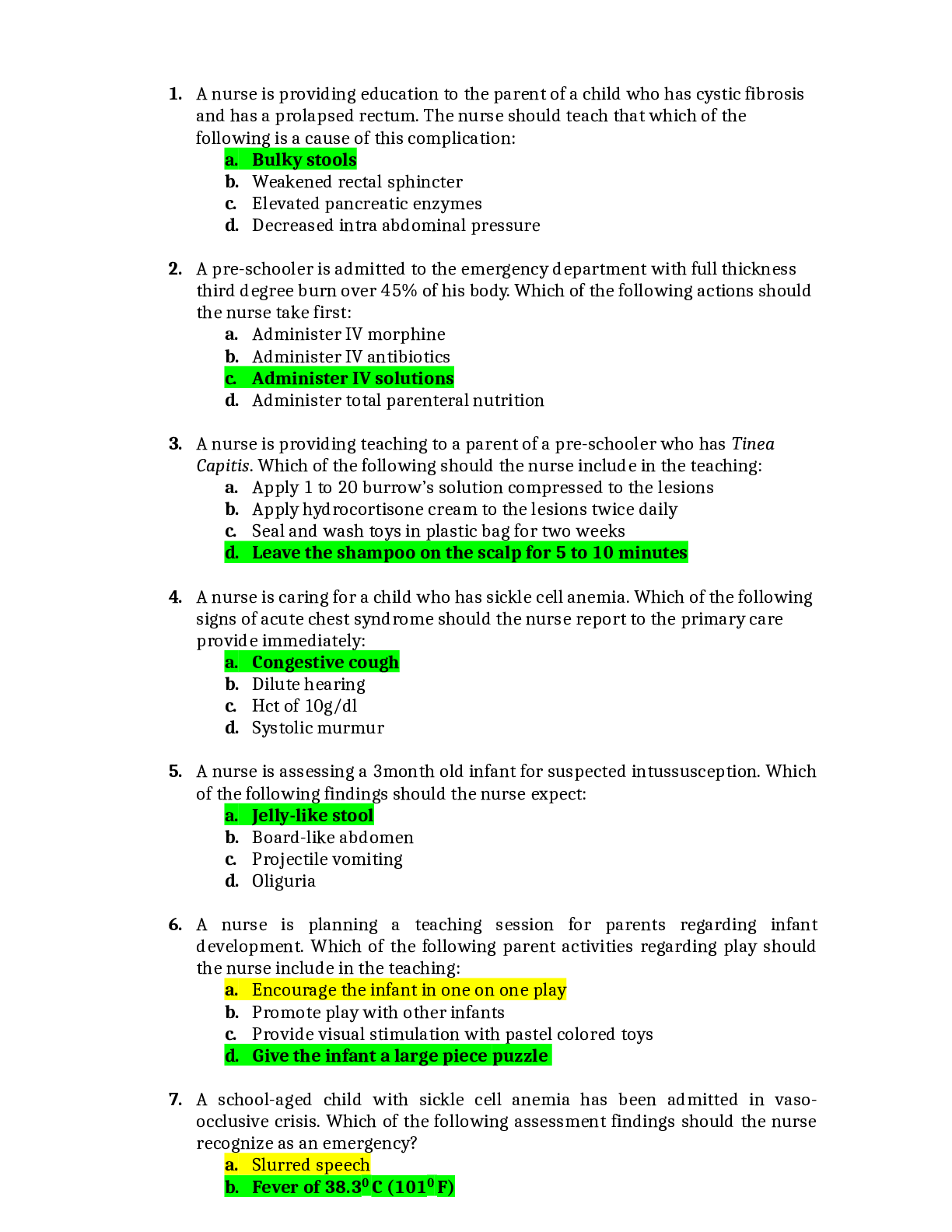
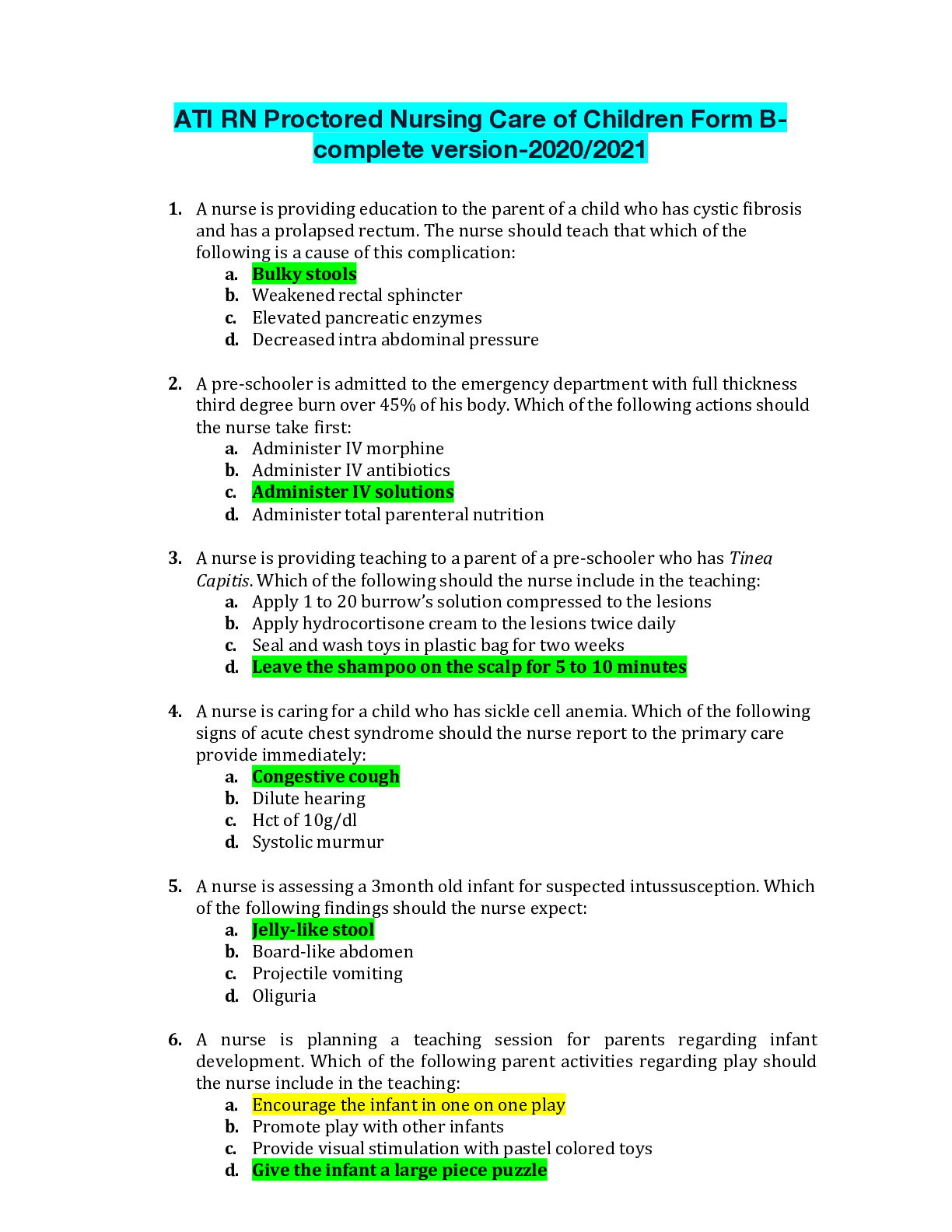
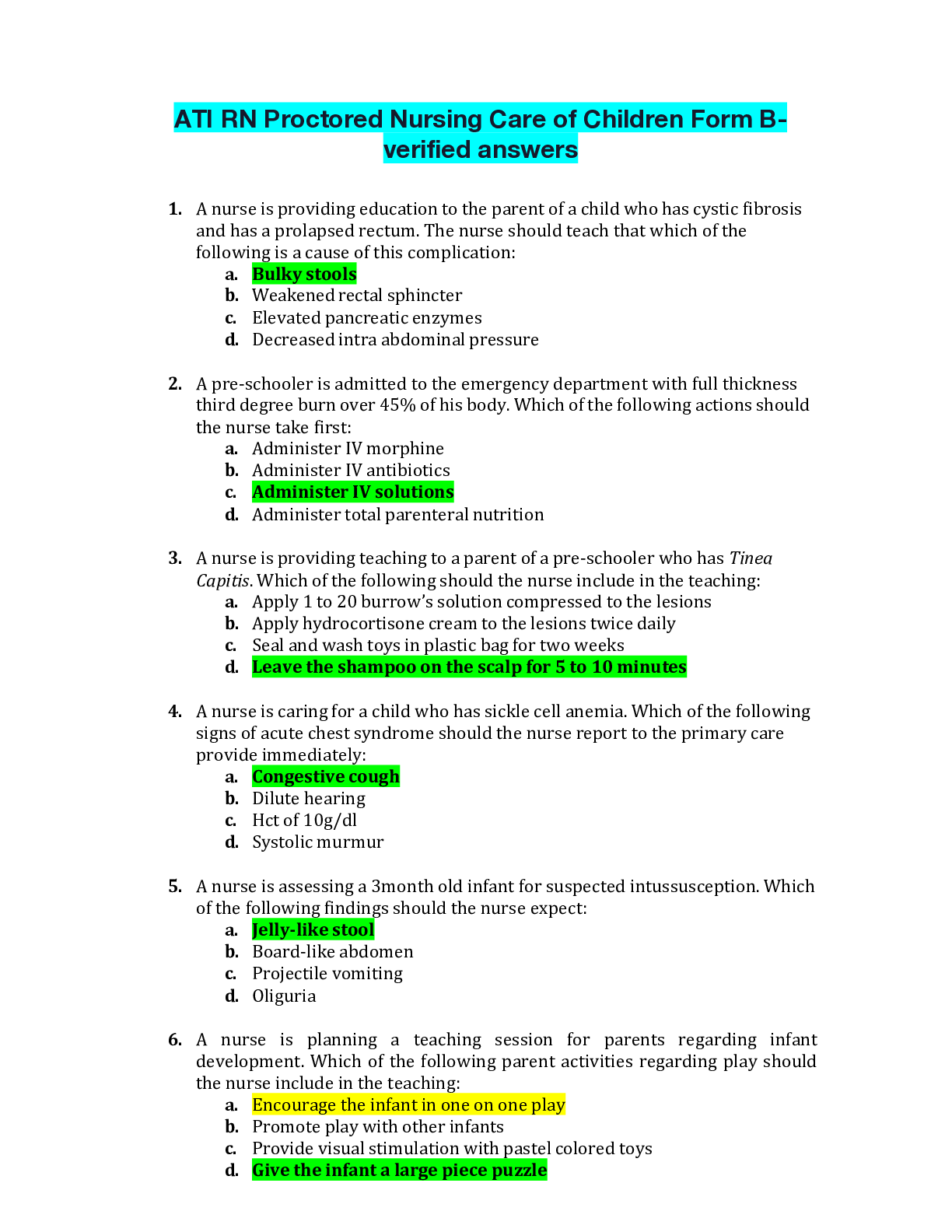
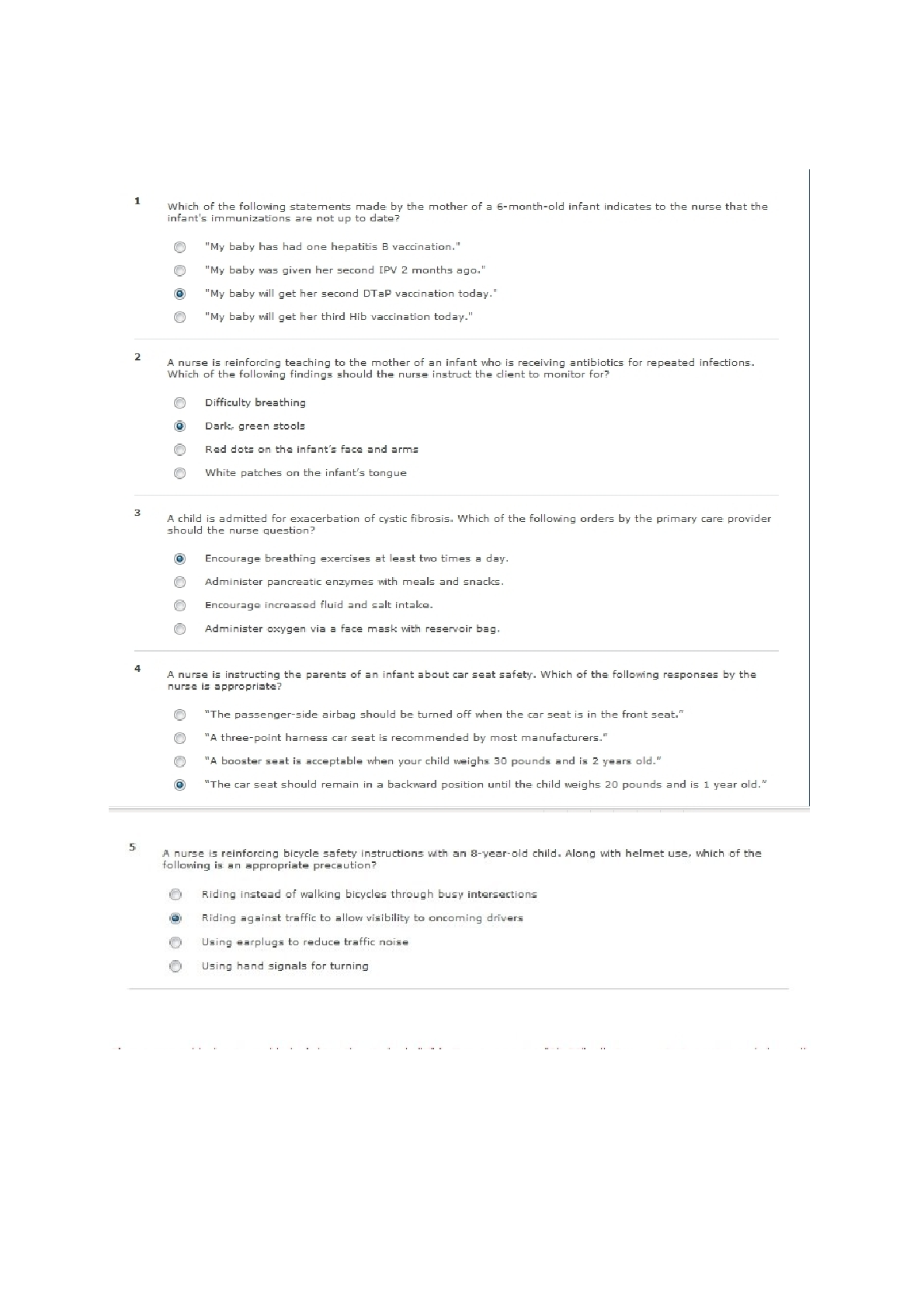
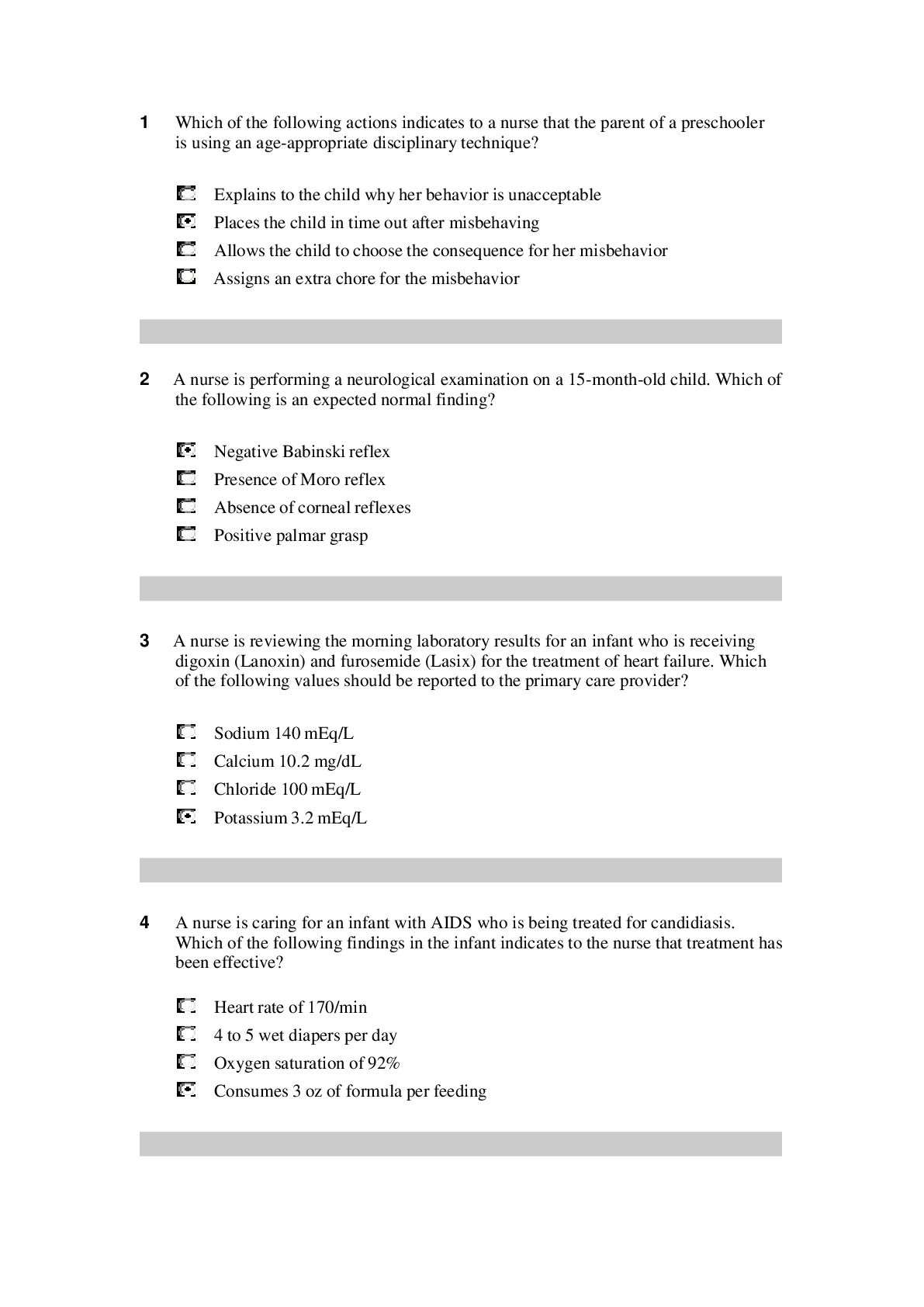
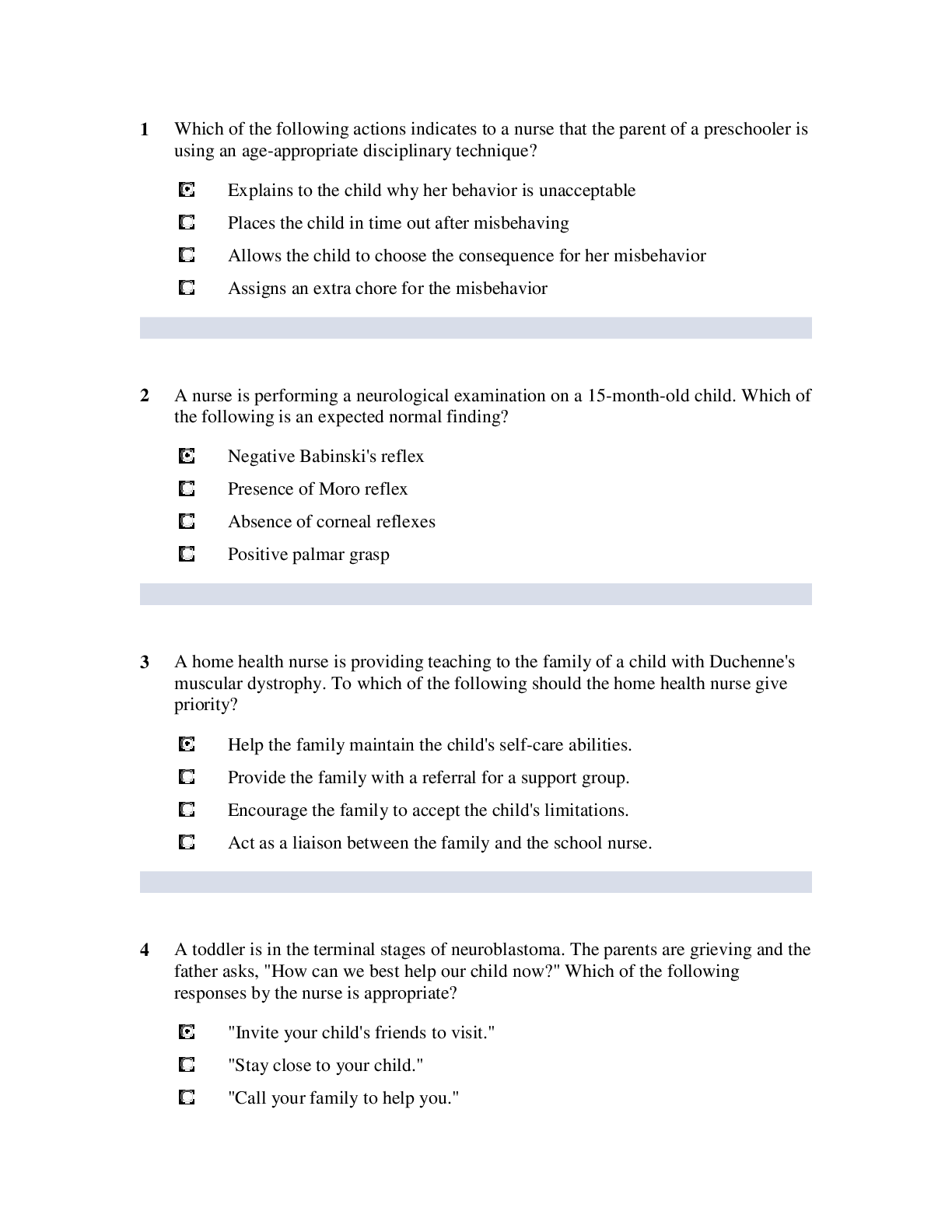
.png)


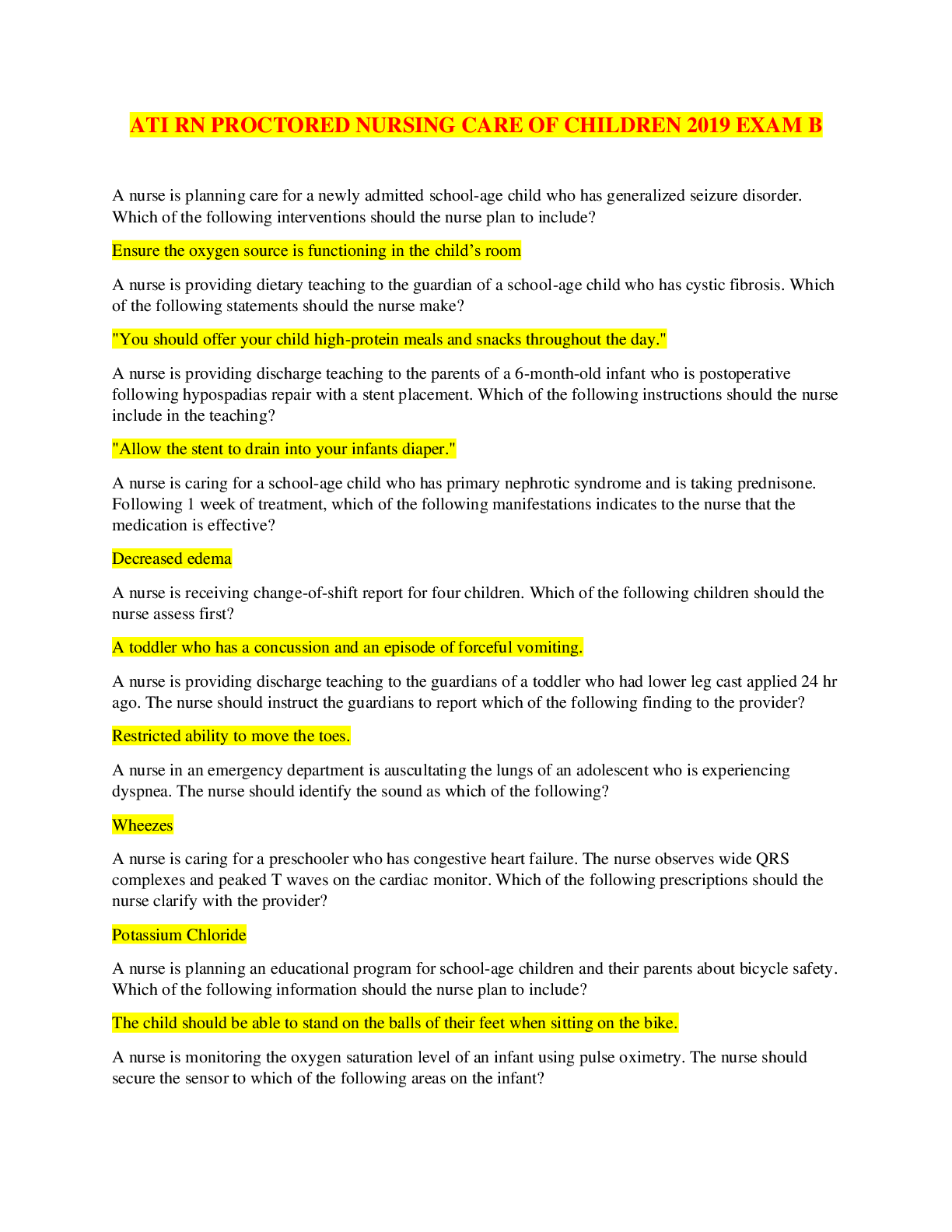

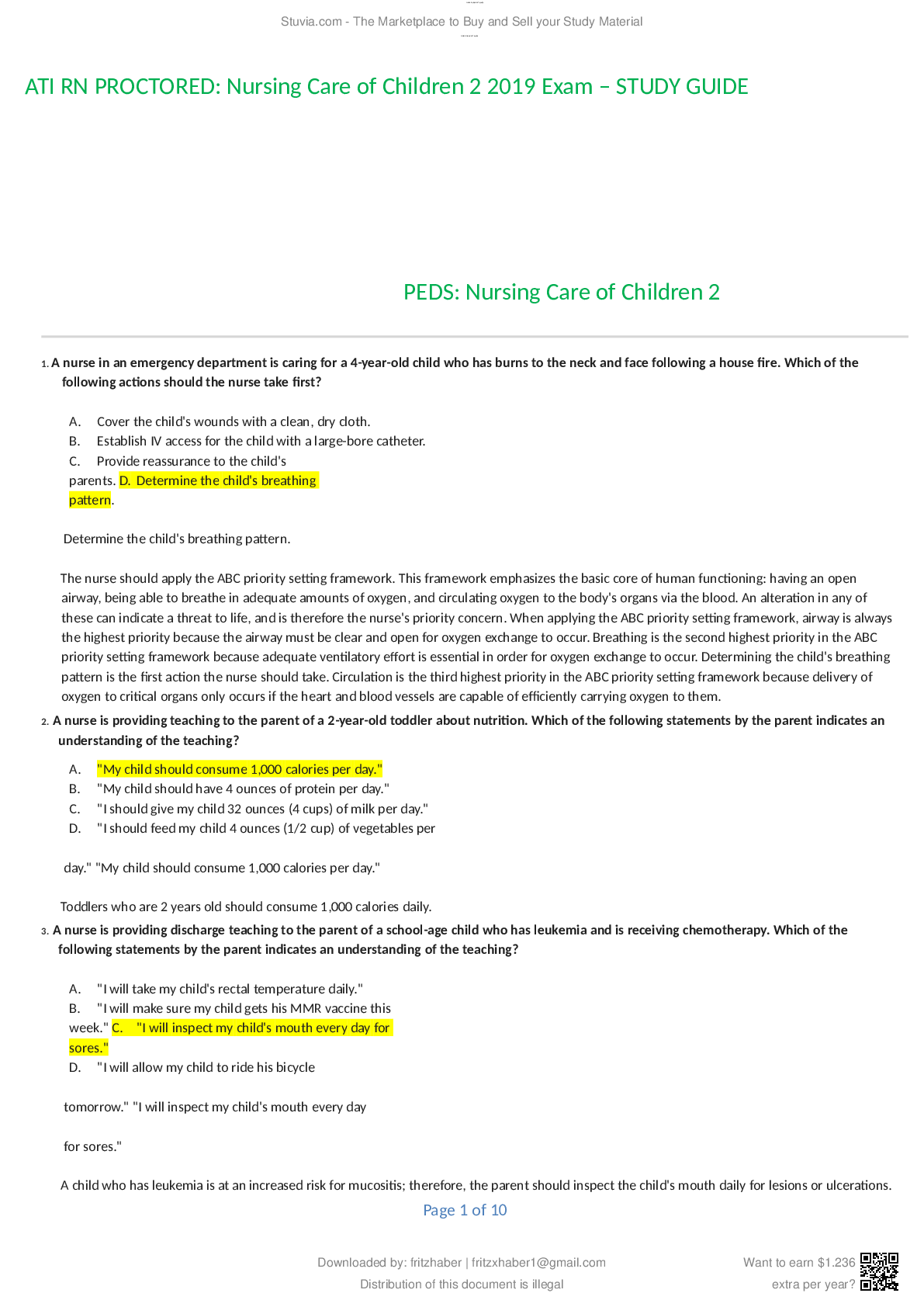
_1.png)

